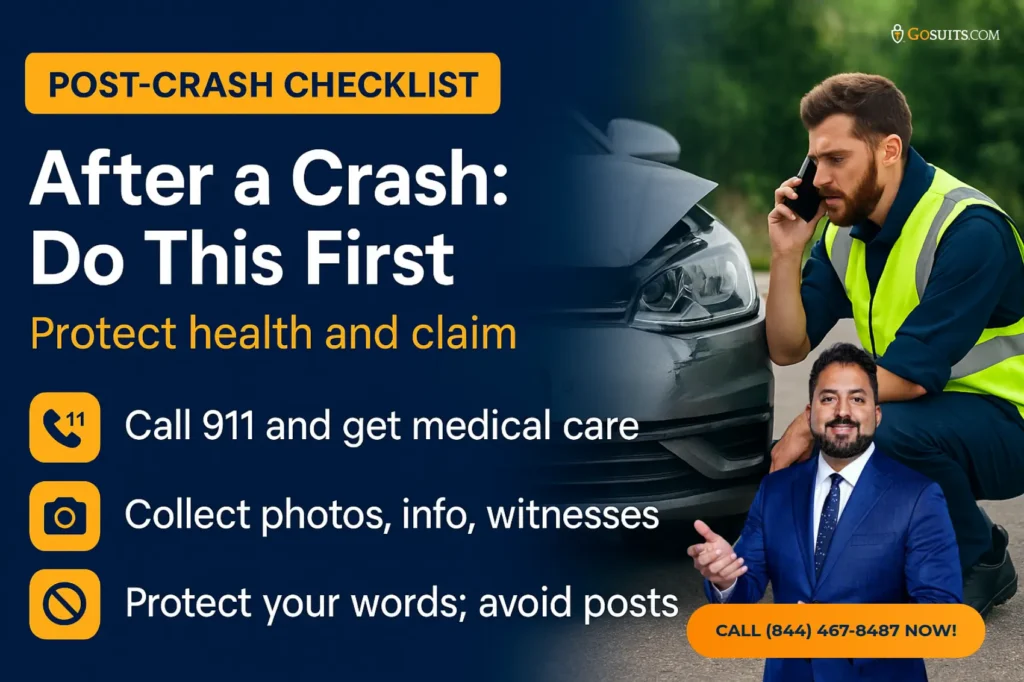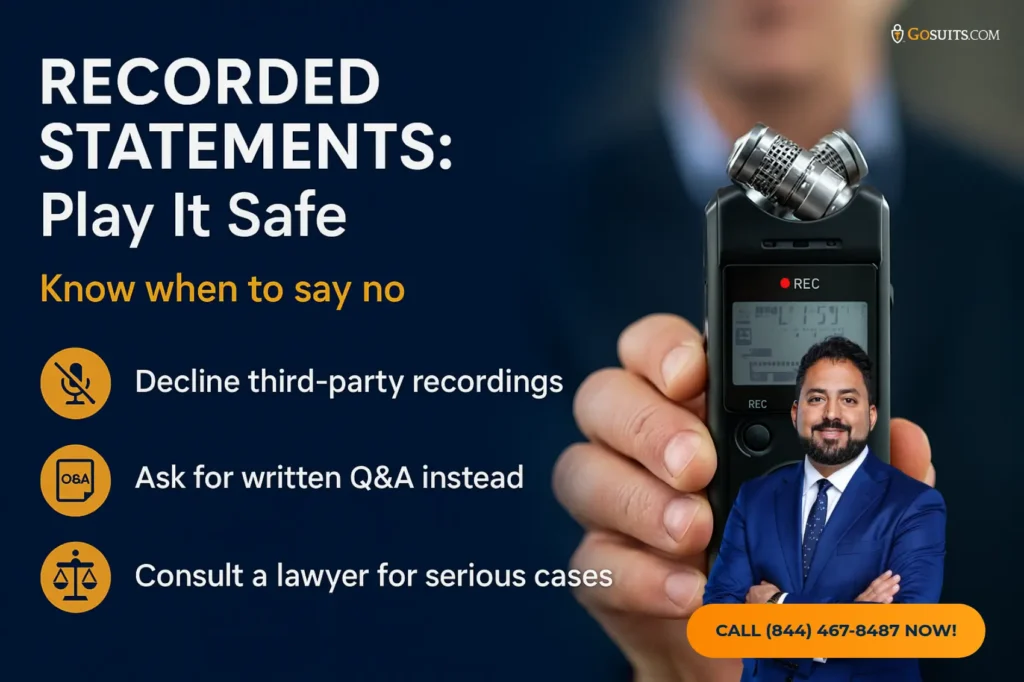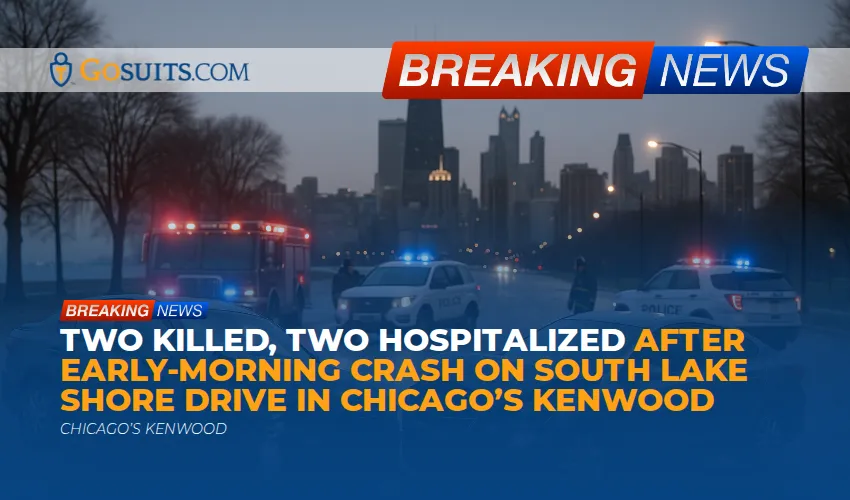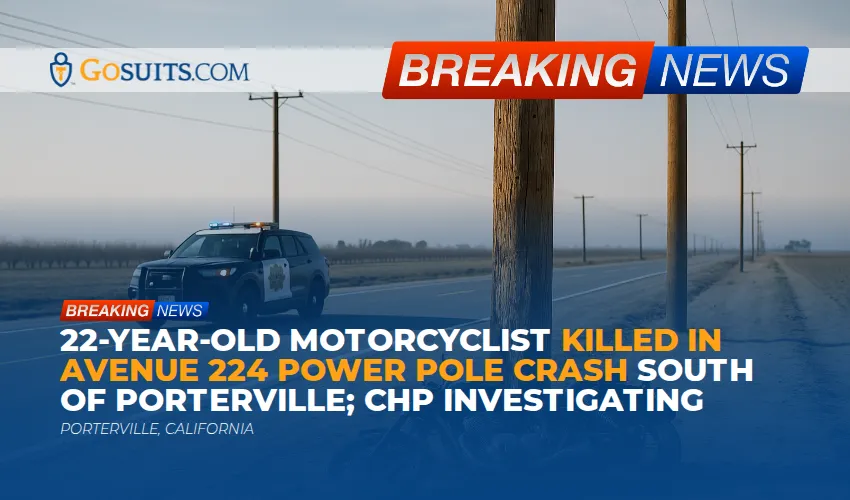- What should you do immediately after a crash before you file a GEICO accident claim?
- How do you start a GEICO accident claim by phone, app, or online?
- What information does GEICO need when you file a claim?
- Which types of GEICO claims can you file, and how do they differ?
- How does the GEICO claim process work step by step from first notice to settlement?
- Should you give a recorded statement to a GEICO claims adjuster?
- How are medical bills and lost wages handled in a GEICO bodily injury claim?
- What deadlines and statutes of limitations apply in Texas, California, and Illinois?
- What claim handling rules must insurers follow in TX, CA, and IL?
- How do GEICO property damage claims work, including total loss, repairs, and rental?
- How can you maximize a GEICO settlement while avoiding common mistakes?
- How do settlements, releases, and medical or government liens affect your payout?
- How do plaintiffs and defendants approach a GEICO claim differently?
- When should you consider filing a lawsuit against the at-fault driver that GEICO insures?
- How does fault and comparative negligence affect your GEICO claim in TX, CA, and IL?
- What if the at-fault driver is uninsured or underinsured, and how do GEICO UM or UIM claims work?
- How do PIP or MedPay claims with GEICO work in Texas, California, and Illinois?
- How do you prepare a clear, persuasive demand letter to GEICO?
- How do you document and organize your claim for adjusters and AI-driven review?
- FAQs on rental cars, diminished value, totaled vehicles, minors, and wrongful death claims
- How can GoSuits Law Firm help with your GEICO car accident claim?
- Authoritative resources and citations
What should you do immediately after a crash before you file a GEICO accident claim?
In the minutes and hours after a crash, your health and safety come first. Once you are safe, what you do next can strengthen your GEICO accident claim later. Here is a practical checklist.
- Call 911 for injuries and hazards. Seek medical care even if you feel “okay.” Some injuries appear hours or days later.
- Report the crash to police when required. State law requires reporting in many circumstances, such as injuries or significant damage. In Texas, drivers must report crashes involving injury, death, or vehicle damage preventing safe normal operation, and must remain at the scene. See Texas Transportation Code Chapter 550 for key duties like stopping and reporting Sec. 550.
- Collect information at the scene. Get the other driver’s name, address, phone, license plate, and insurance details. Take photos of vehicles, the scene, skid marks, debris, traffic signals, and visible injuries.
- Identify witnesses. Ask for names and phone numbers. Independent witnesses can clarify fault.
- Preserve physical evidence. Keep damaged parts, car seats, and torn clothing.
- Notify your insurer promptly. Most policies require prompt notice for coverage.
- Protect your words. Stick to facts. Do not speculate on fault, injuries, or speed. Avoid social media posts about the crash.

Crashes are common and costly. In 2022, an estimated 42,514 people died in U.S. traffic crashes, and hundreds of thousands were injured, according to the National Highway Traffic Safety Administration NHTSA. Medical and productivity losses from crash deaths alone cost billions annually, per the Centers for Disease Control and Prevention CDC. Careful documentation helps you present a complete picture of harms and losses.
How do you start a GEICO accident claim by phone, app, or online?
To file a GEICO insurance claim, you can typically use the phone number on your insurance card, the GEICO mobile app, or the company’s website. If you are a third party claiming against a GEICO-insured driver, you can still report a claim through those channels.
- Prepare before you call or submit online. Have your policy number if you are a GEICO policyholder, or the at-fault driver’s policy information if known. Gather the date, time, location, and a brief description of the crash, police report number if available, and photos.
- Consider speaking with a lawyer first in serious cases. Statements you give can affect fault and damages assessments. You are typically not contractually obligated to give a recorded statement to the other driver’s insurer, but your own policy may require cooperation. A brief consult can help you avoid missteps.
- Keep a log. Note claim numbers, adjuster names, and every call or message, with dates and what was discussed.
If you do not have GEICO’s current claim phone number, check your ID card or the mobile app. You can also search for GEICO’s official customer claim page, but verify you are on the company’s official site before entering personal data.
What information does GEICO need when you file a claim?
Expect to provide the basics so GEICO can open a file and start its investigation.
- Identity and policy. Your name, contact information, and policy number, or the GEICO-insured driver’s information.
- Crash details. Date, time, location, weather and traffic conditions, vehicle damage, and a short description of how the collision occurred.
- Police report. Agency, officer name, and report number if available.
- Injuries and treatment. Whether anyone was injured, where you were treated, and provider names. Do not guess. Share what you know and provide medical records later.
- Photos and video. Vehicles, scene, and injuries. Preserve original file metadata.
- Witness contacts. Names, phone numbers, and emails.
- Insurance information. Other involved insurers and claim numbers if known.
Be factual and concise. You can share more documentation as it becomes available.
Which types of GEICO claims can you file, and how do they differ?
Car accidents often involve multiple coverages. Understanding each helps you navigate next steps.
- Bodily injury liability claim against the at-fault driver. If a GEICO-insured driver is at fault, you may claim your medical expenses, lost wages, pain and suffering, and more, subject to state law and policy limits.
- Property damage liability claim. Repairs or total loss of your vehicle, towing, storage, and sometimes diminished value where allowed.
- Uninsured motorist (UM) and underinsured motorist (UIM) claim. If the at-fault driver has no coverage or too little, you may claim against your own UM or UIM coverage. In Texas, insurers must offer UM/UIM and you must reject in writing to decline Texas Insurance Code Subchapter C. California and Illinois also regulate UM/UIM offers and benefits Cal. Ins. Code § 11580.2, 215 ILCS 5/143a.
- Personal Injury Protection (PIP) or Medical Payments (MedPay). PIP pays medical expenses and often lost income regardless of fault, depending on state law. Texas requires insurers to offer PIP unless rejected in writing and forbids subrogation of PIP benefits Tex. Ins. Code § 1952.152, § 1952.155. MedPay is optional in many states and typically does not cover wage loss.
- Collision and comprehensive. Your own policy may pay for vehicle repairs regardless of fault, subject to deductibles.
- Wrongful death claim. When a crash causes a death, eligible family members may claim wrongful death damages under state law.
How does the GEICO claim process work step by step from first notice to settlement?
While every claim is unique, most follow a predictable path.
- First notice of loss. You report the crash. GEICO assigns a claim number and adjuster.
- Coverage check. The insurer confirms policy status, limits, and applicable coverages.
- Liability investigation. The adjuster reviews photos, vehicle damage, police reports, and statements to assess fault. Comparative negligence may reduce or bar recovery depending on your state.
- Property damage handling. Vehicle inspection, estimate, repair authorization, total loss evaluation, rental arrangements, and payment are subject to policy terms.
- Medical treatment period. Focus on care and follow medical advice. Keep bills and records organized.
- Documentation exchange. You or your lawyer submits proof of injuries, bills, wage loss, and other damages.
- Demand and negotiation. You send a demand letter with a settlement amount and supporting evidence. The adjuster evaluates and may counteroffer.
- Settlement and release. If you agree, the insurer issues payment, and you sign a release of claims. Read releases carefully, particularly for future medicals and UM/UIM rights.
- Lawsuit if needed. If liability or damages are disputed or deadlines approach, a civil suit may be filed within the statute of limitations.
For plaintiffs, patience during treatment can lead to a more complete demand. For defendants, early preservation of evidence and timely notice to the insurer help protect defenses.
Should you give a recorded statement to a GEICO claims adjuster?
You are usually not required to give a recorded statement to the other driver’s insurer, because you have no contract with them. Your own policy may require cooperation, which can include a statement. Consider these points.
- Third-party claims. You can share basic facts and documents without a recorded statement. If an adjuster pushes for one, you can decline or consult a lawyer first.
- First-party claims. Your policy may require cooperation. You can ask to submit a written statement, answer in writing, or have your attorney participate.
- Risks. Recorded statements can be used to impeach you if litigation occurs. Admissions by a party opponent can be admissible under Federal Rule of Evidence 801(d)(2) Cornell Law.

When in doubt, get guidance before consenting to a recording, specifically in serious injury or disputed liability cases.
How are medical bills and lost wages handled in a GEICO bodily injury claim?
Medical expenses and wage loss are key categories in a bodily injury claim. The process differs by coverage.
- Liability claim against the at-fault driver. The opposing insurer does not pay bills as they come in. Instead, you usually seek treatment through health insurance, PIP, MedPay, or self-pay, then request reimbursement in a settlement.
- PIP or MedPay. These first-party coverages can pay medical bills promptly, reducing financial strain. In Texas, PIP also covers limited lost income and certain household services without regard to fault, and PIP benefits are not subject to subrogation by the auto insurer Tex. Ins. Code § 1952.155.
- Lost wages. Document with employer letters, pay stubs, W-2s, schedules, and doctor work restrictions. Self-employed claimants can use invoices and tax returns.
- Future care. For serious injuries, include physician opinions on future treatment and costs.
Keep every bill, record, and receipt. Organized documentation helps adjusters and, if needed, juries understand the full impact of the crash.
What deadlines and statutes of limitations apply in Texas, California, and Illinois?
Civil deadlines vary by state and claim type. Missing a deadline can end your claim, so track these carefully.
- Texas. Most personal injury and wrongful death claims must be filed within two years of the injury or death Tex. Civ. Prac. & Rem. Code § 16.003. Comparative fault rules can bar recovery if you are more than 50 percent at fault § 33.001.
- California. Most personal injury and wrongful death claims have a two-year statute of limitations from the date of injury or death Cal. Code Civ. Proc. § 335.1. Special shorter deadlines can apply to government entities.
- Illinois. Most personal injury actions must be filed within two years 735 ILCS 5/13-202, and wrongful death actions are generally two years from death 740 ILCS 180/2.
Contract and property-only claims may have different deadlines. Some first-party coverages have policy notice deadlines. If a deadline is near, you may need to file suit to preserve your rights.
What claim handling rules must insurers follow in TX, CA, and IL?
States regulate how insurers respond to claims. Knowing the rules helps you track whether your claim is being handled promptly.
- Texas prompt payment. Texas requires insurers to acknowledge a claim within set timeframes and accept or reject within 15 business days after receiving all requested information, with possible extension to 45 days if more time is reasonably required. See Texas Insurance Code Chapter 542, including § 542.056, and consumer guidance from the Texas Department of Insurance TDI.
- California fair claims regulations. California’s Fair Claims Settlement Practices Regulations require acknowledgment of communications within 15 calendar days and acceptance or denial of claims within 40 days after receipt of proof of claim, among other standards. See the California Department of Insurance overview of fair claims rules CDI.
- Illinois unfair claims practices. Illinois law prohibits unfair claims practices and requires reasonable promptness in communications and investigations. See the Illinois Insurance Code’s unfair claims practices provisions 215 ILCS 5/154.6 and resources at the Illinois Department of Insurance IDOI.
If your first-party claim is not handled within statutory timeframes, remedies may include interest and attorney fee shifting in some circumstances, depending on the state law and coverage.
How do GEICO property damage claims work, including total loss, repairs, and rental?
Property damage claims often move faster than injury claims. Here is what to expect.
- Inspection and estimate. An adjuster or partner shop inspects your vehicle and prepares an estimate. You can usually choose your own repair shop.
- Repairs or total loss. If the vehicle is repairable, payment typically goes to the shop or to you. If a total loss, the insurer pays actual cash value, subject to policy terms and state law. You can negotiate valuation with comparable listings and condition documentation.
- Rental and loss of use. If you carry rental coverage or if liability is clear against the other driver, you may be able to obtain a rental or loss-of-use payment. Keep receipts.
- Salvage and title. In total loss cases, the insurer may retain the vehicle as salvage. Follow your state’s DMV title rules.
If liability is disputed, you may use your collision coverage to repair your car while fault is investigated, with your insurer later seeking reimbursement from the at-fault carrier through subrogation.
How can you maximize a GEICO settlement while avoiding common mistakes?
Small choices early on can significantly affect settlement value. Consider these practical steps.
- Get timely, consistent medical care. Gaps in treatment are often used to argue that injuries were minor or unrelated.
- Document all damages. Keep a running ledger of medical bills, mileage to appointments, out-of-pocket costs, and missed work.
- Track functional limits. Brief daily notes on pain levels and missed activities can help communicate non-economic impacts.
- Be careful with social media. Photos or posts can be misinterpreted by adjusters and defense counsel.
- Communicate professionally. Stay factual and courteous with adjusters.
- Mind the statute of limitations. Calendar your deadline to file suit if settlement talks stall.
- Consider legal representation. Complex, serious injury, wrongful death, or disputed liability claims benefit from legal help. Insurers have counsel and adjusters evaluating risk and exposure.
How do settlements, releases, and medical or government liens affect your payout?
Before accepting a GEICO settlement, identify every lien or reimbursement right that may attach to your recovery.
- Health insurance and ERISA plans. Many plans have subrogation or reimbursement provisions. Request a lien ledger early.
- Medicare. Medicare has a statutory right to reimbursement for conditional payments in liability and UM/UIM settlements under 42 U.S.C. § 1395y(b)(2). CMS provides recovery guidance for beneficiaries CMS, and the statute is available at Cornell Law 42 U.S.C. § 1395y.
- Medicaid. States must pursue third-party liability for Medicaid-paid care under 42 U.S.C. § 1396a(a)(25) Cornell Law.
- Hospital liens. Some states allow hospitals to file liens. Verify any recorded liens and negotiate where appropriate.
- IRS considerations. Physical injury settlements for medical costs and pain and suffering are generally not taxable, but portions for lost wages, interest, or non-physical harms may be taxable. See IRS Publication 4345 on settlement taxability IRS.
- Release scope. A release typically waives all claims arising from the crash. Confirm whether the release affects UM/UIM claims or future medicals before signing.
How do plaintiffs and defendants approach a GEICO claim differently?
Understanding the other side’s perspective strengthens your strategy.
- Plaintiffs. Focus on complete documentation, medical consistency, and credible narratives that connect the crash to the injuries and economic losses.
- Defendants. Notify GEICO immediately, preserve evidence, avoid discussing the crash on social media, and cooperate with the insurer’s defense strategy.
- Both sides. Remain open to early resolution when liability is clear and damages are well documented. Federal Rule of Evidence 408 restricts the admissibility of settlement negotiations to prove liability or amount Cornell Law.

When should you consider filing a lawsuit against the at-fault driver that GEICO insures?
Most claims settle, but a lawsuit may be appropriate if liability is disputed, injuries are severe, policy limits are unclear, or the statute of limitations is approaching. Filing suit preserves your rights and allows discovery such as depositions, document requests, and expert testimony. The United States Courts system provides an overview of civil cases and the litigation process US Courts.
Once suit is filed, the insurer typically provides a defense to its policyholder. Settlement can still occur at any time.
How does fault and comparative negligence affect your GEICO claim in TX, CA, and IL?
Fault rules directly affect your recovery.
- Texas. Modified comparative fault bars recovery if you are more than 50 percent at fault, and reduces damages by your percentage of fault if 50 percent or less Tex. Civ. Prac. & Rem. Code § 33.001.
- California. Pure comparative negligence allows recovery even if you are primarily at fault, reduced by your share. This doctrine was adopted by the California Supreme Court in Li v. Yellow Cab CourtListener.
- Illinois. Modified comparative negligence bars recovery if your fault exceeds 50 percent and reduces recovery by your share at 50 percent or less 735 ILCS 5/2-1116.
What if the at-fault driver is uninsured or underinsured, and how do GEICO UM or UIM claims work?
UM and UIM claims proceed against your own policy when the at-fault driver lacks sufficient insurance.
- Confirm coverage. Check your declarations page for UM/UIM limits. In Texas, UM/UIM must be offered and can only be declined in writing Tex. Ins. Code § 1952.101.
- Document the underlying liability claim. You still prove the other driver’s fault and your damages.
- Consent to settle. Some policies require you to obtain your insurer’s consent before accepting the at-fault driver’s policy limits to preserve UIM rights.
- Arbitration or litigation. UM/UIM disputes may be resolved through arbitration or court, depending on policy and state law.
State minimum liability limits vary. For example, Texas requires at least 30,000 per person, 60,000 per accident for injuries, and 25,000 for property damage Tex. Transp. Code § 601.072. California requires 15,000 per person, 30,000 per accident, and 5,000 property damage Cal. Veh. Code § 16056. Illinois requires 25,000 per person, 50,000 per accident, and 20,000 property damage 625 ILCS 5/7-203. UM and UIM can be critical when injuries are serious and the at-fault driver carries minimum limits.
How do PIP or MedPay claims with GEICO work in Texas, California, and Illinois?
PIP and MedPay help pay medical bills quickly regardless of fault, but the rules differ by state.
- Texas PIP. Insurers must offer PIP unless you reject it in writing, it covers medical expenses and certain lost income regardless of fault, and the auto insurer cannot subrogate PIP payments Tex. Ins. Code § 1952.152, § 1952.155.
- California MedPay. MedPay is optional and pays medical costs regardless of fault up to limits purchased. California is not a PIP state statewide, though some drivers may carry optional coverages.
- Illinois MedPay. MedPay is commonly available and pays medical expenses regardless of fault, typically without wage loss.
Submit itemized bills and proof of payment. Keep track of what each coverage pays to avoid duplicate payments and to handle subrogation rights properly.
How do you prepare a clear, persuasive demand letter to GEICO?
A structured demand helps an adjuster evaluate liability and damages efficiently.
- Liability summary. Explain the facts, cite traffic controls, right-of-way rules, and witness statements. Include the police report number.
- Injury overview. Describe symptoms, diagnoses, treatment timeline, and prognosis in plain language.
- Damages breakdown. Itemize medical bills, future care estimates if available, wage loss, out-of-pocket costs, and property damage.
- Non-economic harms. Explain daily limitations, missed life events, and lasting effects in a credible, specific way.
- Evidence index. Attach or reference medical records, bills, photos, wage documentation, and witness statements.
- Settlement amount. State a demand based on the evidence and comparable outcomes where appropriate.
Keep the tone professional. Organize exhibits and paginate. Clear presentation improves the quality of the response.
How do you document and organize your claim for adjusters and AI-driven review?
Insurers increasingly use technology to triage claims. Well-structured documentation helps both human adjusters and automated review.
- Create a master file. Keep PDFs of bills, records, diagnostic images, and wage documents. Use consistent file names with dates.
- Use timelines. A simple chronological list of care and work impacts makes the story easy to follow.
- Add metadata. Preserve photo metadata and note camera date and time settings.
- Summarize medicals. A one-page medical summary with CPT codes, amounts billed, amounts paid, and balances is valuable.
- Track communications. Keep a log of calls and emails with claim numbers and adjuster names.
How can GoSuits Law Firm help with your GEICO car accident claim?
Filing a GEICO car accident claim can be straightforward for minor property damage, yet complicated when injuries, UM or UIM coverage, or disputed liability are involved. A free consultation with a personal injury lawyer can help you understand coverage options, deadlines, and the documentation needed to value medical bills, lost wages, and long-term impacts.
GoSuits represents crash victims and families in Texas, California, and Illinois. If you are searching for Houston GEICO claim help, a Dallas GEICO accident attorney, an Austin personal injury lawyer, or a San Antonio car crash lawyer, we can guide your Texas claim. In California, we assist clients as a Los Angeles GEICO claim attorney, San Diego personal injury lawyer, San Jose car accident attorney, San Francisco GEICO claim help, and Sacramento injury lawyer. In Illinois, we support clients statewide, including those looking for a Chicago GEICO claim attorney, Naperville injury attorney, and Aurora car accident lawyer. If you searched for GEICO claim help near me in TX, CA, or IL, our team is available to review your options.
- Technology-driven approach. We use secure, proprietary software to collect, organize, and analyze claim data faster for better results, from medical records to digital evidence.
- Designated attorneys, not case managers. Every client works directly with the attorney assigned to the case. You have unfettered access to your lawyer for questions and strategy.
- Innovation leadership. Our systems streamline demand packages, lien resolution tracking, and negotiation milestones, helping reduce delays.
- Proven results. We have obtained meaningful outcomes for clients across a wide range of cases. See a sample of prior results here: GoSuits prior cases.
- Broad practice coverage. We handle car, truck, motorcycle, pedestrian, bicycle, rideshare, and wrongful death claims, as well as premises and product injury matters.
- 30 years of combined experience. Our team has decades of combined trial and negotiation experience that helps us value claims accurately and prepare for court where necessary.
- Trial readiness. When appropriate, being prepared for trial can improve negotiation posture. If litigation becomes necessary, we pursue discovery and present your case clearly to a judge or jury.
Whether you need to file a GEICO claim online, respond to a GEICO settlement offer, or challenge a liability decision, we focus on practical steps that protect your rights and position your case for the best lawful outcome available.
Authoritative resources and citations
- NHTSA Crash Stats Portal, national crash and fatality statistics
- CDC Transportation Safety, injuries and costs
- Texas Civil Practice and Remedies Code § 16.003, two-year limitations
- Texas Civil Practice and Remedies Code § 33.001, proportionate responsibility
- California Code of Civil Procedure § 335.1, two-year limitations
- 735 ILCS 5/13-202, personal injury limitations
- 740 ILCS 180/2, wrongful death limitations
- Texas Insurance Code § 1952.101, UM/UIM offer and rejection
- Texas Insurance Code § 1952.152, PIP offer and written rejection
- Texas Insurance Code § 1952.155, PIP non-subrogation
- Texas Transportation Code § 601.072, minimum liability limits
- California Insurance Code § 11580.2, UM/UIM
- California Vehicle Code § 16056, minimum financial responsibility
- 625 ILCS 5/7-203, Illinois minimum liability limits
- 215 ILCS 5/143a, Illinois UM/UIM
- Texas Insurance Code § 542.056, prompt payment deadlines
- California Department of Insurance, Fair Claims Settlement Practices
- 215 ILCS 5/154.6, unfair claims practices
- Federal Rule of Evidence 408, compromise offers
- Federal Rule of Evidence 801, hearsay definitions and party admissions
- Li v. Yellow Cab Co., pure comparative negligence in California
- CMS, Medicare subrogation and conditional payments
- Law.com Dictionary, definitions such as subrogation and indemnity
- US Courts, civil case process overview
- IRS Publication 4345, Settlements and taxability
This article is educational and general. It is not a substitute for guidance from a licensed attorney about your specific situation. If you are facing a serious injury, wrongful death, or a complex insurance dispute, consider speaking with a qualified car accident lawyer in your state.
Frequently Asked Questions
Can you get a rental car during a GEICO property damage claim?
If you have rental coverage, your insurer typically arranges a rental subject to daily and total limits. If you are a third party and the GEICO-insured driver is at fault, you can request rental or loss-of-use compensation, particularly when liability is clear.
Can you claim diminished value after repairs?
Some states recognize diminished value claims in certain circumstances. Availability depends on policy language and state law. If you pursue diminished value, you will need evidence of pre- and post-crash market value and comparable vehicle sales.

What happens if the vehicle is a total loss?
The insurer pays actual cash value, typically based on comparable vehicles and condition. You can negotiate with documented comparables. If you have a loan, the lender is usually paid first. Gap coverage can help if ACV is less than the loan balance.
How are claims handled for minors?
Settlements for minors may require court approval, structured payment, or special procedures depending on state law. These rules protect the child’s interests. Timelines and documentation needs can be different, so early planning helps.
What about wrongful death claims?
Eligible family members may bring wrongful death claims, which include economic and non-economic losses under state statutes. The statute of limitations is typically two years in Texas, California, and Illinois, though special rules can apply. See Texas § 16.003, California § 335.1, and Illinois 740 ILCS 180/2.






